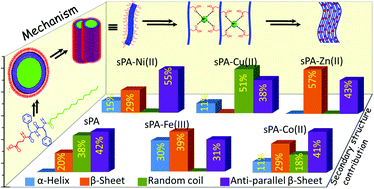Transition metal ions induced secondary structural transformation in a hydrophobized short peptide amphiphile†
Abstract
The precise control over self-assembling structures created by a rationally designed hydrophobized short peptide amphiphile (sPA) was studied. Bioactive transition metal ions were used to transform the supramolecular structures of this sPA. We aimed to understand the role of different transition metal ions in modulating the self-assembly of the sPAs. The presence and contribution of various secondary structures were quantitatively studied by Fourier transform infrared (FT-IR) spectroscopy, which corresponded well with microscopy observations and was further supported by computational methods. The rational incorporation of di-phenylalanine in a previously designed sPA sequence was the new addition to the sequentially studied sPAs and represents another method of alteration that can impart data regarding ion-responsive behavior to the self-assembly process. Such an approach will contribute to the design and development of stimuli-responsive novel biomaterials for numerous applications.

- This article is part of the themed collection: #RSCPoster Conference


 Please wait while we load your content...
Please wait while we load your content...